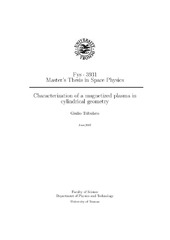Outlier classification using autoencoders: Application for fluctuation driven flows in fusion plasmas
Permanent lenke
https://hdl.handle.net/10037/15048Dato
2019-01-16Type
Journal articleTidsskriftartikkel
Peer reviewed
Sammendrag
Understanding the statistics of fluctuation driven flows in the boundary layer of magnetically confined plasmas is desired to accurately model the lifetime of the vacuum vessel components. Mirror Langmuir probes (MLPs) are a novel diagnostic that uniquely allow us to sample the plasma parameters on a time scale shorter than the characteristic time scale of their fluctuations. Sudden large-amplitude fluctuations in the plasma degrade the precision and accuracy of the plasma parameters reported by MLPs for cases in which the probe bias range is of insufficient amplitude. While some data samples can readily be classified as valid and invalid, we find that such a classification may be ambiguous for up to 40% of data sampled for the plasma parameters and bias voltages considered in this study. In this contribution, we employ an autoencoder (AE) to learn a low-dimensional representation of valid data samples. By definition, the coordinates in this space are the features that mostly characterize valid data. Ambiguous data samples are classified in this space using standard classifiers for vectorial data. In this way, we avoid defining complicated threshold rules to identify outliers, which require strong assumptions and introduce biases in the analysis. By removing the outliers that are identified in the latent low-dimensional space of the AE, we find that the average conductive and convective radial heat fluxes are between approximately 5% and 15% lower as when removing outliers identified by threshold values. For contributions to the radial heat flux due to triple correlations, the difference is up to 40%.
Beskrivelse
This article may be downloaded for personal use only. Any other use requires prior permission of the author and AIP Publishing. This article appeared in the Review of Scientific Instruments, 90, 013505, and may be found at https://doi.org/10.1063/1.5049519.
Forlag
American Institute of PhysicsSitering
Kube, R., Bianchi, F.M., Brunner, D. & LaBombard, B. (2019). Outlier classification using autoencoders: Application for fluctuation driven flows in fusion plasmas. Review of Scientific Instruments, 90, 013505. https://doi.org/10.1063/1.5049519Metadata
Vis full innførselSamlinger
Relaterte innførsler
Viser innførsler relatert til tittel, forfatter og emneord.
-
Studies of plasma potential with emissive probes in the low temperature plasma experiment NJORD
Schregel, Christian-Georg (Master thesis; Mastergradsoppgave, 2012-11-02)In this thesis, the concept of an emissive probe has been used to obtain the plasma potential in the low temperature plasma experiment NJORD. An emissive probe is a probe concept in which a wire is heated strong enough to emit a Richardson current. The probe is then swept through several voltage biases and thus, an I-V trace obtained. With the current from the emission and the collected current, ... -
Beam and plasma properties downstream from positively biased source chamber
Osnes, Sindre (Master thesis; Mastergradsoppgave, 2017-06-06)We study the effect of changing the separation grid bias in a double plasma device from -50 V to the same bias as the anode in the source chamber, 115 V on the plasma and beam parameters downstream in the target chamber. Two different probes were used to analyze the downstream plasma. We used an RFEA-probe to obtain information about the ions, such as the ion energy distribution and we constructed ... -
Characterization of a magnetized plasma in cylindrical geometry
Tribulato, Giulio (Master thesis; Mastergradsoppgave, 2007-06)Njord is a novel plasma device in which a low-temperature plasma is produced by RF waves inductively coupled into a cylindrical, magnetized vacuum. The main part of this project is to carry out an experimental characterization of the plasma in this device. The plasma expansion and acceleration of the source plasma into the main chamber will be of specific interest. The ultimate aim will then be to ...


 English
English norsk
norsk


